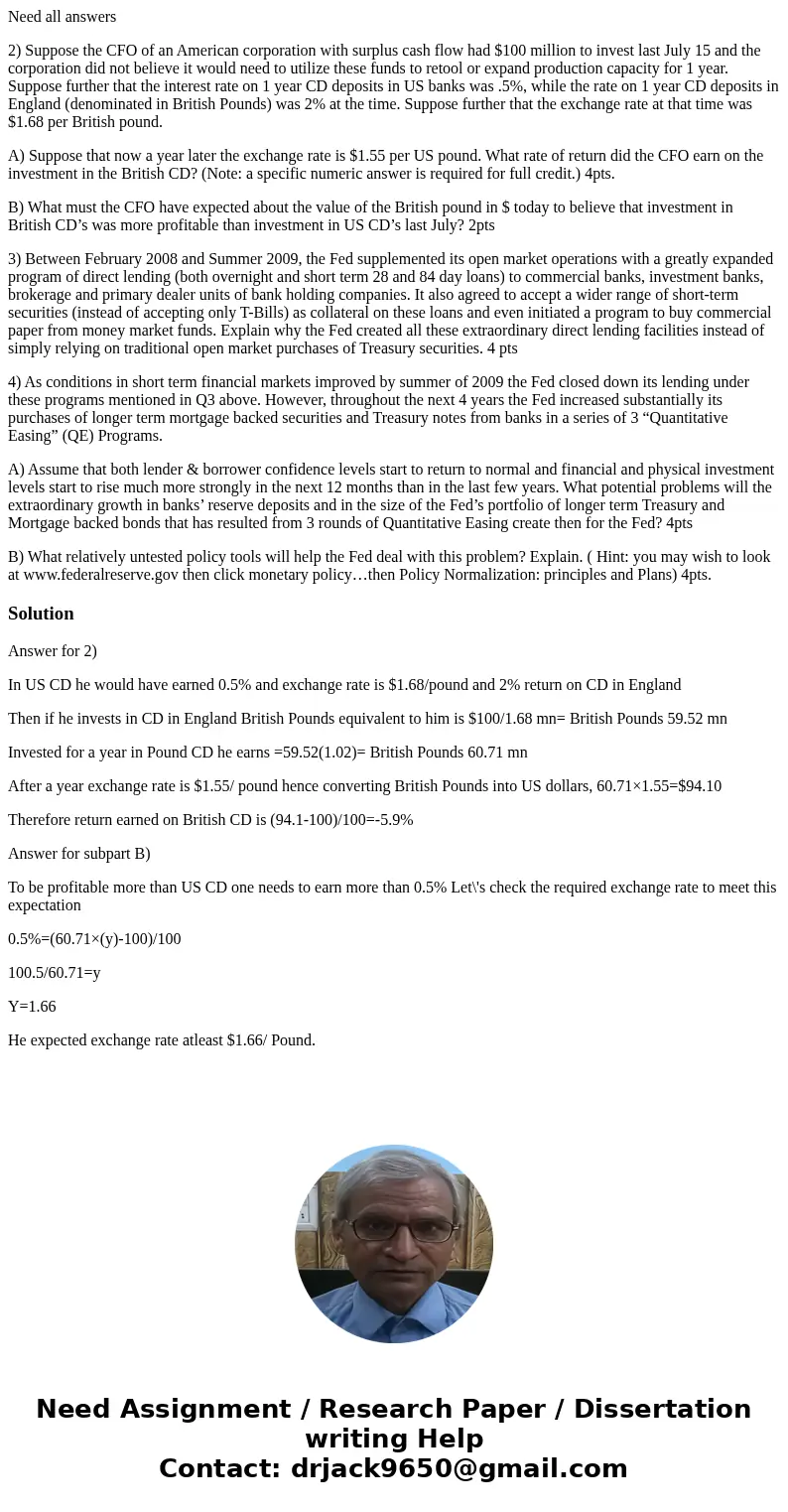Need all answers 2 Suppose the CFO of an American corporatio
Need all answers
2) Suppose the CFO of an American corporation with surplus cash flow had $100 million to invest last July 15 and the corporation did not believe it would need to utilize these funds to retool or expand production capacity for 1 year. Suppose further that the interest rate on 1 year CD deposits in US banks was .5%, while the rate on 1 year CD deposits in England (denominated in British Pounds) was 2% at the time. Suppose further that the exchange rate at that time was $1.68 per British pound.
A) Suppose that now a year later the exchange rate is $1.55 per US pound. What rate of return did the CFO earn on the investment in the British CD? (Note: a specific numeric answer is required for full credit.) 4pts.
B) What must the CFO have expected about the value of the British pound in $ today to believe that investment in British CD’s was more profitable than investment in US CD’s last July? 2pts
3) Between February 2008 and Summer 2009, the Fed supplemented its open market operations with a greatly expanded program of direct lending (both overnight and short term 28 and 84 day loans) to commercial banks, investment banks, brokerage and primary dealer units of bank holding companies. It also agreed to accept a wider range of short-term securities (instead of accepting only T-Bills) as collateral on these loans and even initiated a program to buy commercial paper from money market funds. Explain why the Fed created all these extraordinary direct lending facilities instead of simply relying on traditional open market purchases of Treasury securities. 4 pts
4) As conditions in short term financial markets improved by summer of 2009 the Fed closed down its lending under these programs mentioned in Q3 above. However, throughout the next 4 years the Fed increased substantially its purchases of longer term mortgage backed securities and Treasury notes from banks in a series of 3 “Quantitative Easing” (QE) Programs.
A) Assume that both lender & borrower confidence levels start to return to normal and financial and physical investment levels start to rise much more strongly in the next 12 months than in the last few years. What potential problems will the extraordinary growth in banks’ reserve deposits and in the size of the Fed’s portfolio of longer term Treasury and Mortgage backed bonds that has resulted from 3 rounds of Quantitative Easing create then for the Fed? 4pts
B) What relatively untested policy tools will help the Fed deal with this problem? Explain. ( Hint: you may wish to look at www.federalreserve.gov then click monetary policy…then Policy Normalization: principles and Plans) 4pts.
Solution
Answer for 2)
In US CD he would have earned 0.5% and exchange rate is $1.68/pound and 2% return on CD in England
Then if he invests in CD in England British Pounds equivalent to him is $100/1.68 mn= British Pounds 59.52 mn
Invested for a year in Pound CD he earns =59.52(1.02)= British Pounds 60.71 mn
After a year exchange rate is $1.55/ pound hence converting British Pounds into US dollars, 60.71×1.55=$94.10
Therefore return earned on British CD is (94.1-100)/100=-5.9%
Answer for subpart B)
To be profitable more than US CD one needs to earn more than 0.5% Let\'s check the required exchange rate to meet this expectation
0.5%=(60.71×(y)-100)/100
100.5/60.71=y
Y=1.66
He expected exchange rate atleast $1.66/ Pound.

 Homework Sourse
Homework Sourse